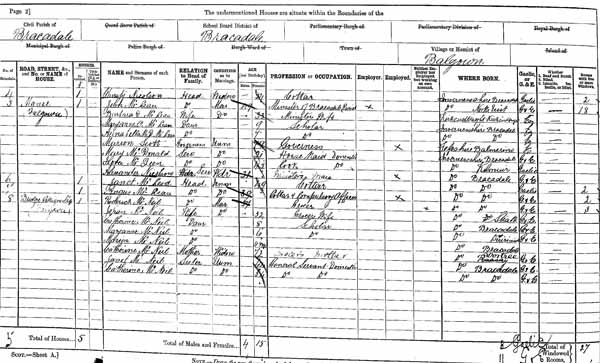1891 Census
1891 Census
The 1891 Census was taken on Sunday 5 April under the provisions of the Act for Taking the Census of Scotland (53 & 54 Vict c.38). The Commission appointed under the Local Government (Scotland) Act 1889 was still in the process of assessing the boundaries of civil parishes and counties at the time.
The population of Scotland on 5 April 1891 was 4,033,103.
This guide covers 1891 Census questions and provides links to 1891 Census street indexes.
1891 Census Questions
There were several changes and one new question:
- categories for disabilities were revised to: deaf and dumb; blind; and lunatic, imbecile or idiot
- three columns were added to identify whether a person was employed or an employer or working on their own account but no reference was made to unemployment
- a count of the Gaelic speaking population had been made in 1881 but the 1891 Census included a question on whether a person spoke Gaelic (G) or Gaelic and English (G & E).
This example is from the 1891 Census for the hamlet of Balgown in the parish of Bracadale on the Isle of Skye (our reference 1891/109/3, page 2). It shows that most of the inhabitants spoke both Gaelic and English. The minister is the only employer.
1891 Census Street Indexes
Census street indexes provide registration district (RD) and enumeration district (ED) references for each street in a city or urban area. They also cover institutions such as asylums, hospitals, workhouses, prisons, police stations and barracks as well as hotels and public buildings.
There are 22 street indexes for the 1891 census. They have been digitised and are made available as pdf files that are several megabytes in size.
If you can’t find a particular street it may not have existed in 1891 or may have had a different name.
- Aberdeen
- Ayr
- Barvas, Carloway, Lochs, Stornoway and Uig
- Bothwell and Holytown
- Cambusnethan
- Dalziel
- Dundee
- Dunfermline
- Edinburgh
- Glasgow
- Greenock
- Hamilton
- Hawick and Wilton
- Inverness
- Kilmarnock
- Kirkcaldy and Dysart
- Montrose
- New Monkland
- Old Monkland
- Paisley
- Perth, Kinnoull and Scone
- Shotts, Calderhead and Cadder
